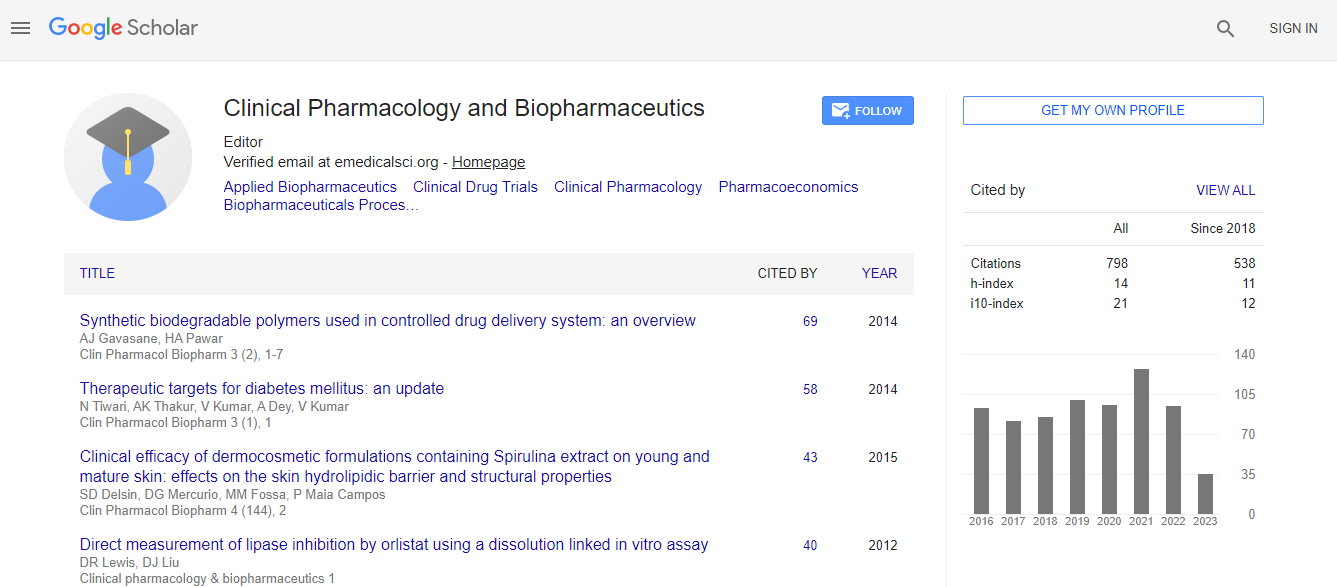Our Group organises 3000+ Global Conferenceseries Events every year across USA, Europe & Asia with support from 1000 more scientific Societies and Publishes 700+ Open Access Journals which contains over 50000 eminent personalities, reputed scientists as editorial board members.
Open Access Journals gaining more Readers and Citations
700 Journals and 15,000,000 Readers Each Journal is getting 25,000+ Readers
Google Scholar citation report
Citations : 1089
Clinical Pharmacology & Biopharmaceutics received 1089 citations as per Google Scholar report
Clinical Pharmacology & Biopharmaceutics peer review process verified at publons
Indexed In
- CAS Source Index (CASSI)
- Index Copernicus
- Google Scholar
- Sherpa Romeo
- Genamics JournalSeek
- RefSeek
- Hamdard University
- EBSCO A-Z
- OCLC- WorldCat
- Publons
- Euro Pub
- ICMJE
Useful Links
Recommended Journals
Related Subjects
Share This Page
A usual coordination of isatin with metal (II) complexes of Tetradentate Schiff base ligand: Synthesis, characterization, DNA binding and catalytic activity
3rd International Conference on Clinical Pharmacy
Ahmed M Abu-Dief, Laila H Abdel Rahman and Samar Kamel Hamdan
Sohag University, Egypt
ScientificTracks Abstracts: Clin Pharmacol Biopharm
Abstract
Air and moisture stable coordination compounds of first transition metals such as Co (II), Ni (II) and Cu (II) with newly designed Schiff base (bsiph) incorporating 5-bromosalicyaldehyde (bs) with isatin and 4-nitro-o-phenylene diamine (nph) have been synthesized. The molecular structure of ligand and its complexes were characterized by elemental analyses, IR, 1H and 13C NMR, TGA and electronic spectroscopy. Conductivity and magnetic susceptibility measurements were used to elucidate the structure of the newly prepared metal complexes. The analytical and spectroscopic tools suggested that the prepared Schiff base ligand behave as mono basic tetra-dentate ONNO ligand and bind to metal (II) ion in octahedral geometry according to the general formula [M(bsiph)x(H2O)].n(H2O) where M=Cu(II), Co(II) and Ni(II), x=OAC-, NO3- and n=number of hydrated water molecules. The binding properties of the investigated complexes with Calf thymus (CT-DNA) were investigated by using electronic spectra and viscosity measurements. Moreover, DNA cleavage activity of the prepared Schiff base complexes was monitored by gel electrophoresis. Furthermore, the Schiff base and its complexes were screened for antimicrobial activity against gram positive bacteria (Staphylococcus aureus), gram negative bacteria (Escherichia coli, Pseudomonas aeroginosa) and fungi (Aspergillus flavus, Candida albicans and Trichophyton rubrum). The results showed that the metal complexes were more reactive with respect to its ligand.Biography
Email: ahmed_benzoic@yahoo.com

 Spanish
Spanish  Chinese
Chinese  Russian
Russian  German
German  French
French  Japanese
Japanese  Portuguese
Portuguese  Hindi
Hindi 
